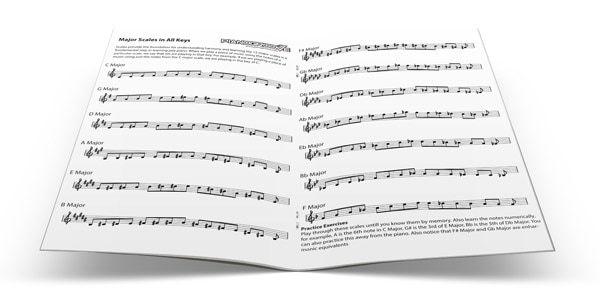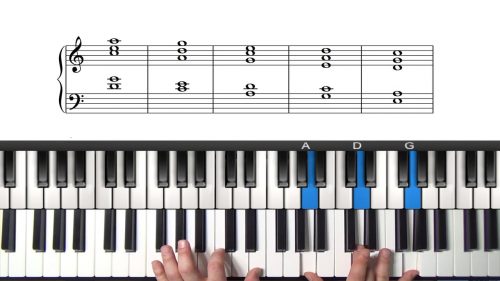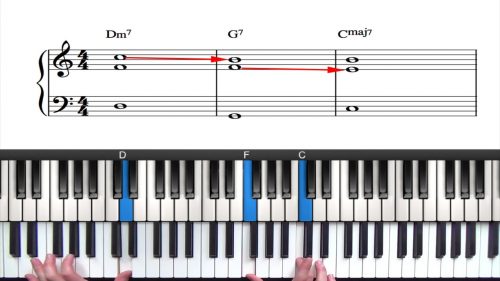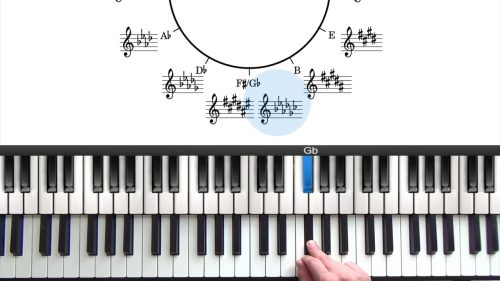Pentatonic Scale Improvisation
In this lesson I’m going to provide an introduction to pentatonic scales for jazz piano.
The theory that we cover in this lesson is important for the upcoming study of pentatonic harmony. This is where we take a 5 note pentatonic scale and create these 4th based voicings voicings that can be heard in the recordings of more modern jazz musicians such as Herbie Hancock & Chick Corea.
Similar to the pentagon, which has 5 sides, the pentatonic scale is a 5 note scale which can be used in any key for improvisation.
Pentatonic scales are the oldest musical scales in the word.
Despite the age and history of the pentatonic scale, it is used extensively in modern jazz improvisation.
In this lesson we are going to look at the construction of the pentatonic scale and discuss what gives it such a unique sound. We will then explore the application of the scale from a jazz improvisation standpoint applying the scale to number of different chord types and common progressions.
Downloadable Lesson Supplement:
Download a PDF containing the major pentatonic scales in all 12 keys:
So How Do We Construct The Pentatonic Scale?
The major pentatonic scale is built from tones 1,2,3,5, & 6 of the major scale. Another way of looking at it is a major scale excluding the 4th and 7th degrees. You have a lot of freedom when playing and improvising using pentatonic scales.
This is because the dissonant intervals have been removed from the scale. The dissonant intervals occur where there are half step intervals between the scale degrees.
In every major scale, there is a half step interval between the 3 & 4th notes and another half step between the 7th and 1st note. Looking at the C Major scale. The half step intervals are between the E & F and the B & C.
Removing the dissonant intervals means that any notes of the scale can be played in any order which is why it is easy to manipulate the notes in context of improvisation.
Superimposing Pentatonic Scales
We can get some really cool sounds by superimposing pentatonic scales over different chords types and chord qualities. This kind of sound was popularised in the late 60s and into the 70s by jazz musicians such as McCoy Tyner and John Coltrane
Lesson Downloads
-
Pentatonic Scale Choices Cheat Sheet File Type: pdf
-
12 Minor Pentatonic Scales File Type: pdf
Practice Tips
-
Play up and down the pentatonic scales in fragments to get used to the unusual intervals in the pentatonic scale.
-
Spend time listening to players such as Coltrane and McCoy Tyner to understand the importance of patterns in pentatonic improvisation.
-
Download and print the pentatonic scale cheat sheet. This document outlines some pentatonic formulas for different chord qualities.
-
It's best think in terms of formulas and scale degrees and this information is included. The formulas highlighted in green are some colourful pentatonic relationships to get you started.









Another great lesson – the whole layering thing you explain here was a complete revelation, especially the ascending scales in the ii-V-I-VI at the end. Can’t wait to get to the lesson on pentatonic harmony now!
These kinds of scales also remind me quite a lot of Joe Zawinul in the more African-inflected sound of Weather Report – Black Market, etc. Agree that just using pentatonic all the time can get wearing, although it’s easier to make pretty-sounding stuff quickly than modal improv. The key seems to be quickly developing fluency across all the scales.
Thanks very much for the feedback Martin! I’m glad you enjoyed the lesson and yes I find it very interesting applying pentatonic scales in this way.
The pentatonic harmony lesson is much more challenging and takes a lot of practice to get the voicings down. However, the core principle is the same… we are just using the notes of a superimposed pentatonic scale, only this time we are creating voicings with the scale, as appose to a single note melody line.
Absolutely, always remember that the topics I teach do not exist in isolation. Especially scales, you have the creative freedom to mix and match different scales and also combine them to create hybrid scales. Just like the 251 example where i combined modal scales with fragments of pentatonic scales. Above all else, experiment!
All the best,
Hayden
Hello Hayden, I’m having trouble to figure out fingering for pentatonic scales, any suggestions?
Thank you,
Gustavo
Hi Hayden
Thanks very much for a fantastic lesson. I really like the way you choose the scales for the 2-5-1-6 progression by going up in half steps.
My question is if you improvise over the bridge of a jazz standard, lets say you choose to use Bebop lines, where would you fill in these pentatonic ideas?
Would you improvise in a Bebop style for the 1st 32 bars and then the 2nd time from bars 33 – 64 you would use the same chord progressions and apply the pentatonic harmony? How would you go about this?
If you can give me some ideas it would really advance my playing.
Thanks very much.
Stephan
Hi Stephan,
Pentatonic soling is very different from bebop soloing and so my advice would be to separate them on the form and play them in different sections of the tune.
For example, play through the A Section(s) with bebop lines and licks, and then when you approach them bridge (perhaps the last 2 bars of the A section) introduce a pentatonic line that will set you up for a pentatonic solo in the bridge. This way you are hinting at it before coming to the bridge so it won’t be such a dramatic change.
When you change the style of soloing so dramatically, you should do it when you transition to a new section…. this will make it sounds more intentional and easier to follow. Alternatively you could play once through the whole form with bebop material and then once through with pentatonic material.
If it’s a short form then this could be good. If it’s a long form or a slow tune then the A/B approach would be better.
Another idea…. if you are ‘trading 4s’ or ‘trading 8s’ (which is usually done in place of a drum solo) then when it’s your turn you could throw in some of the pentatonic material to add a new sound to what is being played.
And finally, yes – you can play this material over any chord changes so you wouldn’t need to change the chords for this to work.
Hope this helps!
Hayden
Hi Hayden
I cannot stress enough how much your lessons are helping me. Why did I have to wait so long to get this kind of material? I’ve been through a lot of courses and this is by far the best.
Thanks so much!
Stephan
That’s great Stephan… I’m really glad you are enjoying the course! If I can help you with any of the other material, just let mw know :-) Cheers, Hayden
HI Hayden
Sorry I totally forgot to ask you this question.
Bebop is normally swung and that’s the way I play as well. My question is if you choose to solo over the bridge and the 1st time you play Bebop swung and the 2nd time you incoporate the pentatonic ideas would you also swing the pentatonic licks or can you play it straight?
For me I don’t see how you can mix up swing and playing straight in one tune, but then again there are no rules to jazz so it can probably be done. I just don’t know how.
If you can give me some ideas I will be very grateful!
Thanks very much.
Stephan
Hi Stephan,
You could play either straight or swung. If you’re bebop soloing was swung it would make sense to swing the rest of your solo – in my opinion.
However, this isn’t always the case. ‘On Green Dolphin Street’ for example, is known for switching back and forth between latin and swing feels but this is an unusual tune as far as that is concerned.
Swing, Straight, Bossa, Ballad – is something you would decide before the performance, particularly if you are playing with other musicians… everyone would need to be clear on the feel and how you will be playing the tune.
To clarify, it’s usually best to keep the feel consistent throughout the form so choose either straight or swing beforehand.
Have fun practicing this stuff!
Hayden
Hi….Sorry…I don’t understand…..Why C is the 7b and not the 7 of dm7?
forgive me….
Lorenzo from Italy…..
Hi Lorenzo,
Good question.
Sometimes I use the terms “minor 3rd / minor 7th” and “flat 3rd / flat 7th” interchangeably.
I always relate everything to the major scale, for example, if I think of the D Dorian mode, I think R-2-b3-4-5-6-b7-R.
So if I ever say b7 over a minor chord, I am just referring to the minor 7th in the chord.
I hope that helps and let me know if you have any further questions.
Cheers,
Hayden
Hi Hayden,
Any suggestion for fingerings of major pentatonic scales?
Thank you,
Gustavo
Hi Hayden
In the minor pentatonic scales download the last note in the A minor scale is shown as B. Shouldn’t it be G?
Gary
Hi Gary,
Apologies for the late reply here and thanks for letting me know about this typo. I will fix this shortly and re-upload the PDF file.
Happy new year and enjoy the lessons!
Cheers,
Hayden
killer lesson….never noticed the half step rise for each pentatonic over a 2 5….
ergo…i think u can just approach any 2 5 1 (including 6) with major pent built on the tonic and keep rising a half step over each new chord correct? that’s a cool short cut when you’re just running out of ideas over yet another 2 5 …right?
am i oversimplyfing?